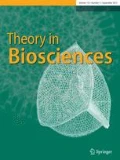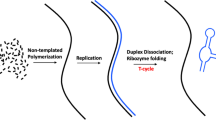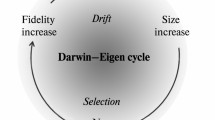Abstract
A model for the formation of the genetic code is presented where protein synthesis is directed initially by tRNA dimers. Proteins that are resistant to degradation and efficient RNA-binders protect the RNAs. Replication becomes elongational producing poly-tRNAs from which the mRNAs and ribosomes are derived. Attributions are successively fixed to tRNAs paired through the perfect palindromic anticodons, with the same bases at the extremities (5′ANA: UNU 3′; GNG: CNC; principal dinucleotides, pDiN). The 5′ degeneracy is then developed. The first pairs to be encoded correspond to the hydropathy correlation outliers (Gly-CC: Pro-GG and Ser-GA: Ser-CU) and to the sector of homogeneous pDiN, composed by two pyrimidines or two purines. These amino acids are preferred in the N-ends of proteins, stabilizers of proteins against catabolism and strong RNA-binders. The next pairs complete the sector of homogeneous pDiN (Asp, Glu-UC: Leu-AG and Asn, Lys-UU: Phe-AA). This set of nine amino acids forms the protein cores with the predominant aperiodic conformation. Next enter the pairs with mixed pDiN (one purine and one pyrimidine), the RY attributions composing the protein N-ends and the YR attributions the C-ends. The last pair contains the main punctuation signs (Ile, Met, iMet-AU: Tyr, Stop-UA). The model indicates that genetic information emerged during the process of formation of the coding/decoding system and that genes were defined by the proteins. Stable proteins constructed the nucleoprotein system by binding to the RNAs that produced them. In this circular rationale, genes are memories in a metabolic system for production of proteins that stabilize it. The simplicity and the highly deterministic character of the process suggest that the Last Universal Common Ancestor populations could be composed, in early stages, of lineages bearing similar genetic codes.



Similar content being viewed by others
References
Baranov PV, Gurvich OL, Hammer AW et al (2003) Recode 2003. Nucleic Acids Res 31:87–89
Barbieri M (2003) The organic codes—an introduction to semantic biology. Cambridge University Press, Cambridge
Berezovsky IN, Kilosanidze G, Tumanyan VG et al (1999) Amino acid composition of protein termini are biased in different manners. Protein Eng 12:23–30
Berthonneau E, Mirande M (2000) A gene fusion event in the evolution of aminoacyl-tRNA synthetases. FEBS Lett 470:300–304
Beuning PJ, Musier-Forsyth K (1999) Transfer RNA recognition by aminoacyl-tRNA synthetases. Biopolymers 52:1–28
Bloch DP, McArthur B, Widdowson R et al (1984) tRNA-rRNA sequence homologies: a model for the generation of a common ancestral molecule and prospects for its reconstruction. Orig Life Evol Biosph 14:571–578
Bloch DP, McArthur B, Guimarães RC et al (1989) tRNA-rRNA sequence matches from inter- and intraspecies comparisons suggest common origins for the two RNAs. Braz J Med Biol Res 22:931–944
Copley SD, Smith E, Morowitz HJ (2005) A mechanism for association of amino acids with their codons and the origin of the genetic code. Proc Nat Acad Sci USA 102:4442–4447
Creighton TE (1993) Proteins: structures and molecular properties. Freeman, New York
Davis BK (1999) Evolution of the genetic code. Prog Biophys Mol Biol 72:157–243
Dawkins R (1976) The selfish gene. Oxford University Press, Oxford
Di Giulio M (2005) The origin of the genetic code: theories and their relationships, a review. BioSystems 80:175–184
Farias ST, Guimarães RC (2007) Aminoacyl-tRNA classes and groups in prokaryotes. J Theor Biol 250:221–229
Farias ST, Moreira CHC, Guimarães RC (2007) Structure of the genetic code suggested by the hydropathy correlation between anticodons and amino acid residues. Orig Life Evol Biosph 37:83–103
Ferreira R, Cavalcanti ARO (1997) Vestiges of early molecular processes leading to the genetic code. Orig Life Evol Biosph 27:397–403
Grantham R (1974) Amino acid difference formula to help explain protein evolution. Science 185:862–864
Grosjean H, Houssier C (1990) Codon recognition: evaluation of the effects of modified bases in the anticodon loop of tRNA using the temperature-jump relaxation method. In: Gehrke CW, Kuo KCT (eds) Chromatography and modification of nucleotides. Elsevier, Amsterdam, pp A255–A295
Grosjean H, Houssier C, Cedergren R (1986) Anticodon-anticodon interactions and tRNA sequence comparison: approaches to codon recognition. In: Knippenberg PH, Hilbers CW (eds) Structure and dynamics of RNA. Plenum, New York, pp 161–174
Guimarães RC (1994) Linguistics of biomolecules and the protein-first hypothesis for the origins of cells. J Biol Phys 20:193–199
Guimarães RC (1996) Anti-complementary order in the genetic coding system. Int Conf Orig Life (ISSOL) 11:100
Guimarães RC (1998) Genetic code: hydropathic, dinucleotide type and aminoacyl-tRNA synthetase class organization. In: Chela-Flores J, Raulin F (eds) Exobiology- matter, energy and information in the origin and evolution of life in the universe. Kluwer, Dordrecht, pp 157–160
Guimarães RC (2001) Two puctuation system in the genetic code. In: Chela-Flores J, Owen T, Raulin F (eds) First steps in the origin of life in the universe. Kluwer, Dordrecht, pp 91–94
Guimarães RC (2002) An evolutionary definition of life—from metabolism to the genetic code. In: Pályi G, Zucchi C, Caglioti L (eds) Fundamentals of life. Elsevier, Paris, pp 95–108
Guimarães RC (2004) The genetic code as a self-referential and functional system. Int Conf Comput Commun Control Technol 7:160–165
Guimarães RC, Moreira CHC (2002) Genetic code structure and evolution – aminoacyl-tRNA synthetases and the principal dinucleotides. In: Pályi G, Zucchi C, Caglioti L (eds) Fundamentals of life. Elsevier, Paris, pp 249–276
Guimarães RC, Moreira CHC (2004) Genetic code: a self-referential and functional model. In: Pályi G, Zucchi C, Caglioti L (eds) Progress in biological chirality. Elsevier, Oxford, pp 83–118. http://eprints.ictp.it/131
Guimarães RC, Moreira CHC, Farias ST (2008) Self-referential formation of the genetic system. In: Barbieri M (ed) The codes of life—the rules of macroevolution. Springer, Dordrecht, pp 68–109
Ibba M, Morgan S, Curnow AW et al (1997) A euryarchaeal lysyl-tRNA synthetase: resemblance to class I synthetases. Science 278:1119–1122
Ibba M, Becker HD, Stathopoulos C et al (2000) The adaptador hypothesis revisited. Trends Biochem Sci 25:311–316
Ibba MP, Rogers TE, Samson R et al (2005) Association between archaeal Prolyl- and Leucyl-tRNA synthetases enhances tRNAPro aminoacylation. J Biol Chem 280:26099–26104
Illangasekare M, Yarus M (1999) A tiny RNA that catalyzes both aminoacyl-tRNA and peptidyl-RNA synthesis. RNA 5:1482–1489
Jablonka E, Lamb MJ (2007) The expanded evolutionary synthesis—a response to Godfrey-Smith, Haig, and West-Eberhard. Biol Philos 22:453–472
Jiménez-Montaño MA (1999) Protein evolution drives the evolution of the genetic code and vice-versa. BioSystems 54:47–64
Klipcan L, Safro M (2004) Amino acids biogenesis, evolution of the genetic code and aminoacyl-tRNA synthetases. J Theor Biol 228:389–396
Knight RD, Freeland SJ, Landweber LF (1999) Selection, history and chemistry: the three faces of the genetic code. Trends Biochem Sci 24:241–247
Knight RD, Freeland SJ, Landweber LF (2001) Rewiring the keyboard: evolvability of the genetic code. Nat Rev Genet 2:49–58
Lacey JC Jr, Mullins DW Jr (1983) Experimental studies related to the origin of the genetic code and the process of protein synthesis—a review. Orig Life Evol Biosph 13:3–42
Legiewicz M, Yarus M (2005) A more complex isoleucine aptamer with a cognate triplet. J Biol Chem 280:19815–19822
Lehmann J (2002) Amplification of the sequences displaying the pattern RNY in the RNA world: the translation → translation/replication hypothesis. J Theor Biol 219:521–537
Markos A (2002) Readers of the book of life—contextualizing developmental evolutionary biology. Oxford UP, Oxford
Martinez-Giménez JA, Tabarés-Seisdedos R (2002) On the dimerization of the primitive tRNAs: implications in the origin of the genetic code. J Theor Biol 217:493–498
Miller DL, Yamane T, Hopfield JJ (1981) Effect of tRNA dimer formation on polyphenylalanine biosynthesis. Biochemistry 20:5457–5461
Nanita SC, Cooks RG (2006) Serine octamers: cluster formation, reactions, and implications for biomolecule homochirality. Angew Chem Int Ed 45:554–569
Oba T, Fukushima J, Maruyama M et al (2005) Catalytic activities of [GADV]-protein world for the emergence of life. Orig Life Evol Biosph 35:447–460
Osawa S (1995) Evolution of the genetic code. Oxford UP, New York
Pardini MIMC, Guimarães RC (1992) A systemic concept of the gene. Genet Mol Biol 15:713–721
Polycarpo C, Ambrogelly A, Bérubé A et al (2004) An aminoacyl-tRNA synthetase that specifically activates pyrrolysine. Proc Nat Acad Sci USA 101:12450–12454
Poole AM, Jeffares DC, Penny D (1998) The path from the RNA world. J Mol Evol 46:1–17
Pouplana LR, Schimmel P (2001) Two classes of tRNA synthetases suggested by sterically compatible dockings on tRNA acceptor stem. Cell 104:191–193
Quevillon S, Agou F, Robinson JC et al (1997) The p43 component of the mammalian multi-synthetase complex is likely to be the precursor of the endothelial monocyte-activating polypeptide II cytokine. J Biol Chem 272:32573–32579
Rodin SN, Ohno S, Rodin A (1993) Transfer RNAs with complementary anticodons: could they reflect early evolution of discriminative genetic code adaptors? Proc Nat Acad Sci USA 90:4723–4727
Schimmel P (1995) An operational RNA code for amino acids and variations in critical nucleotide sequences in evolution. J Mol Evol 40:531–536
Seligmann H, Amzallag GN (2002) Chemical interactions between amino acid and RNA: multiplicity of the levels of specificity explains origin of the genetic code. Naturwissenschaften 89:542–551
Simos G, Sauer A, Fasiolo F et al (1998) A conserved domain within Arc1p delivers tRNA to aminoacyl-tRNA synthetases. Mol Cell 1:235–242
Skouloubris S, Ribas de Pouplana L, Reuse H et al (2003) A noncognate aminoacyl-tRNA synthetase that may resolve a missing link in protein evolution. Proc Nat Acad Sci USA 100:11296–11302
Smith D, Yarus M (1989) tRNA-tRNA interactions within cellular ribosomes. Proc Nat Acad Sci USA 86:4397–4401
Sobolevsky Y, Trifonov EN (2005) Conserved sequences of prokaryotic proteomes and their compositional age. J Mol Evol 61:1–7
Sobolevsky Y, Trifonov EN (2006) Protein modules conserved since LUCA. J Mol Evol 63:622–634
Stathopoulos C, Li T, Longman R et al (2000) One polypeptide with two aminoacyl-tRNA synthetase activities. Science 287:479–482
Szathmáry E (1999) The origin of the genetic code: amino acids as cofactors in an RNA world. Trends Genet 15:223–229
Tamura K, Schimmel P (2003) Peptide synthesis with a template-like RNA guide and aminoacyl phosphate adaptor. Proc Nat Acad Sci USA 100:8666–8669
Trevors JT, Abel DL (2004) Chance and necessity do not explain the origin of life. Cell Biol Int 28:729–739
Trifonov EN (2004) The triplet code from first principles. J Biomol Struct Dyn 22:1–11
Varshavsky A (1996) The N-end rule: functions, mysteries, uses. Biochemistry 93:12142–12149
Wong JTF (2005) Coevolution theory of the genetic code at age thirty. BioEssays 27:416–425
Yamane T, Miller DL, Hopfield JJ (1981) Interaction of elongation factor Tu with the aminoacyl-tRNA dimer Phe-tRNA:Glu-tRNA. Biochemistry 20:449–452
Yang CM (2005) On the structural regularity in nucleobases and amino acids and relationship to the origin and evolution of the genetic code. Orig Life Evol Biosph 35:275–295
Yarus M (2000) Perspectives: protein synthesis—unraveling the riddle of ProCys tRNA synthetase. Science 287:440–441
Acknowledgments
Financial support from PET/MEC to CHCM; doctoral fellowship from CAPES to STF. We deeply appreciate the invaluable contribution of Fatima Cvrckova to the improvement of the text.
Author information
Authors and Affiliations
Corresponding author
Rights and permissions
About this article
Cite this article
Guimarães, R.C., Moreira, C.H.C. & de Farias, S.T. A self-referential model for the formation of the genetic code. Theory Biosci. 127, 249–270 (2008). https://doi.org/10.1007/s12064-008-0043-y
Received:
Accepted:
Published:
Issue Date:
DOI: https://doi.org/10.1007/s12064-008-0043-y




